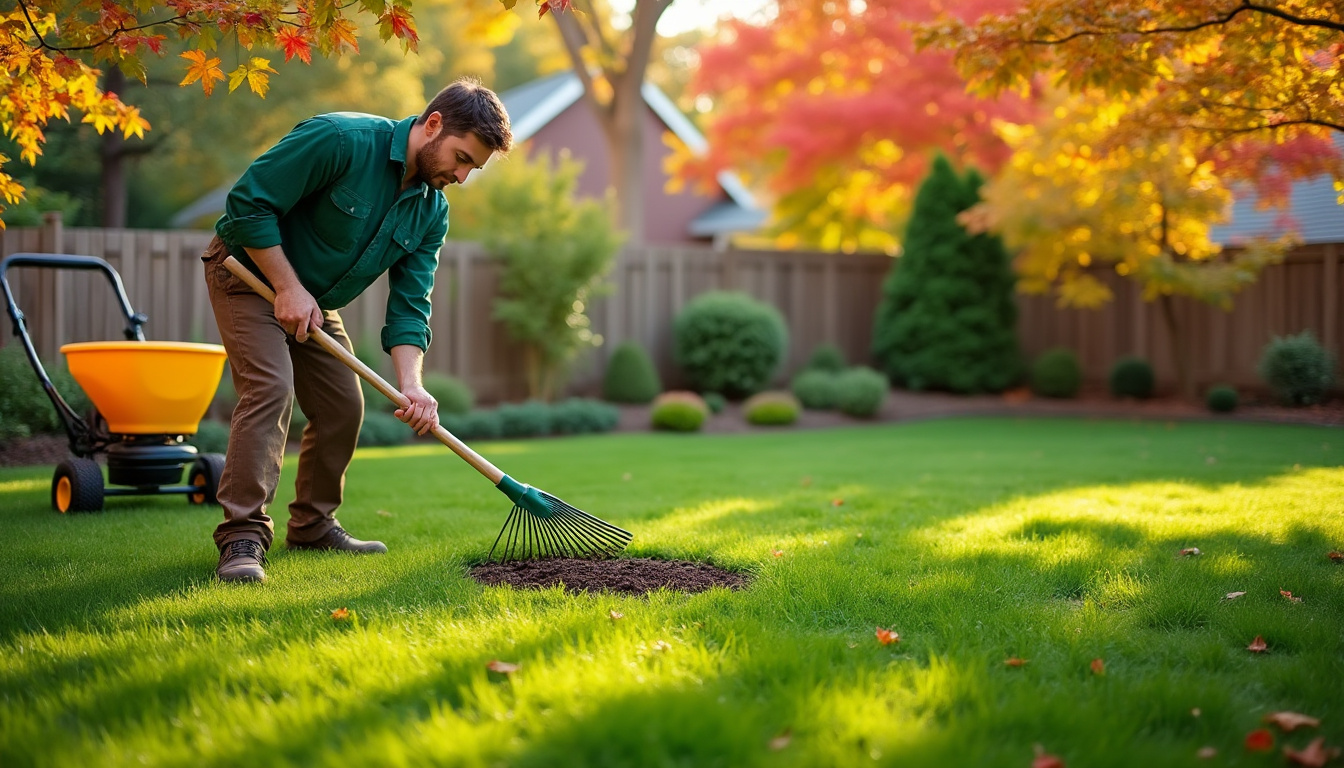As autumn approaches, the window of opportunity for optimal lawn care narrows. Pat Sullivan, a renowned expert in lawn maintenance, offers indispensable guidance to prepare your yard for the colder months ahead. Fall is a crucial season for lawn health, providing the foundation necessary for vigorous growth in spring. Proper techniques during this period can prevent common issues like weed invasion, nutrient depletion, and soil compaction. Incorporating trusted brands such as Scotts for fertilization, Toro for aeration tools, and Miracle-Gro for soil enhancement can elevate your lawn care routine.
Understanding The Importance Of Fall Lawn Care For A Healthy Lawn
The fall season presents a unique opportunity to repair the damage sustained during the hot summer months and to prepare the soil for winter dormancy. Grass roots continue to grow in cooler weather even after the blades have stopped active growth, making autumn an ideal time to encourage deep root development. Pat Sullivan highlights that neglecting lawn care in fall often results in thin, patchy turf the following spring, setting homeowners up for a costly and labor-intensive recovery process.
Maintaining a lush lawn through fall involves critical tasks including weed control, soil aeration, fertilization, and overseeding. Each of these steps not only strengthens your turf’s resilience but also prevents many common problems that arise after the first frost. For example, weeds such as crabgrass and dandelions try to take advantage of weakened lawn conditions during autumn. Identifying and eliminating these weeds early with Ortho herbicides can reduce infestations drastically.
One of the key components Pat emphasizes is timely mowing. Cutting your grass to optimal height with quality equipment like John Deere mowers ensures the grass isn’t stressed while still allowing sufficient leaf area for photosynthesis. Contrary to summer practices, grass should be kept slightly taller in fall to shield roots from frost. Monitoring moisture with irrigation systems from Greenworks can prevent drought stress, which remains a threat until the soil temperature consistently drops below 50°F.
A great fall lawn care regimen also involves soil testing and amendments. Miracle-Gro offers a variety of soil conditioners that balance pH and nutrient content, which, paired with Scotts slow-release fertilizers, ensure a steady supply of nutrients over the coming months. Understanding the specific needs of your lawn type — whether cool-season or warm-season grass — is critical during this phase to tailor treatments effectively.
- Weed identification and removal using Ortho herbicides
- Proper mowing height adjustments with John Deere or BLACK+DECKER equipment
- Deep root stimulation through soil aeration with Toro machinery
- Soil amendment and long-term fertilization using Miracle-Gro and Scotts products
- Implementing watering schedules supported by Greenworks irrigation solutions
| Fall Lawn Care Task | Recommended Tools/Products | Purpose |
|---|---|---|
| Weed Control | Ortho Herbicides | Prevents weed invasion and competition |
| Mowing | John Deere / BLACK+DECKER Mowers | Maintains proper grass height to reduce stress |
| Aeration | Toro Aerators | Reduces soil compaction and encourages root growth |
| Fertilizing | Miracle-Gro / Scotts Fertilizers | Provides essential nutrients for winter hardiness |
| Irrigation | Greenworks Systems | Maintains optimal soil moisture balance |
Expert Weed Management Strategies For Fall Lawn Care
Effective weed control is paramount for maintaining a healthy lawn during fall. Pat Sullivan underscores that proactive weed removal can prevent invasive species from taking hold and exhausting vital nutrients from your turf. According to lawn care research in 2025, many homeowners underestimate the significance of fall weed control, which often leads to persistent winter weeds that are harder to eliminate in spring.
One recommended approach involves a combination of manual removal and targeted herbicide application. Products from Ortho offer selective weed control solutions that effectively remove broadleaf weeds without harming the grass. For more stubborn weeds, a pre-emergent herbicide from Scotts can inhibit seed germination in late fall, reducing the weed load the following year.
Integrating weed removal into routine autumn lawn maintenance can start with identifying the types of weeds present. Resources like Effective Weed Removal Tips provide comprehensive guidance on weed identification and best practices for elimination. Spot treatments targeting dandelions, clover, and crabgrass maximize effectiveness while minimizing chemical use.
Another technique endorsed by Pat Sullivan is maintaining proper lawn density to naturally crowd out weeds. Overseeding with quality seed mixtures from Pennington during fall thickens turf and reduces bare patches where weeds can establish. Husqvarna spreaders and sprayers simplify this process by ensuring even seed and fertilizer distribution.
- Identify common fall weeds like dandelions, clover, and crabgrass
- Apply selective herbicides from Ortho and pre-emergent herbicides by Scotts
- Integrate manual weeding for small infestations
- Enhance turf density with overseeding products from Pennington
- Use Husqvarna spreaders for efficient seed and fertilizer application
| Weed Type | Control Method | Recommended Product |
|---|---|---|
| Broadleaf Weeds | Selective Herbicide | Ortho Targeted Herbicides |
| Crabgrass | Pre-Emergent Herbicide | Scotts Halts Crabgrass Preventer |
| Dandelions | Spot Treatment + Manual Removal | Ortho Weed B Gon |
| Winter Annual Weeds | Fall Pre-Emergent Application | Scotts Turf Builder |
Thorough weed management during the fall not only improves aesthetics but also reduces nutrient competition, ultimately supporting a more resilient lawn in the spring. Additional lawn care advice is available at Fall Lawn Care Tasks.
Optimizing Soil Health Through Fall Aeration And Fertilization Techniques
Soil health forms the backbone of any successful lawn care plan, particularly during fall. According to Pat Sullivan, addressing soil compaction through aeration is one of the most impactful steps you can take. Over time, soil becomes dense due to foot traffic and heavy equipment, restricting oxygen and nutrients from reaching grass roots. Toro and Husqvarna produce advanced aeration tools designed for homeowners and professionals alike, facilitating deep penetration and enhanced root development.
Following aeration, applying a balanced fertilizer tailored for fall season conditions dramatically boosts root strength and nutrient reserves. Scotts and Miracle-Gro offer formulations rich in potassium and phosphorus, key nutrients that improve cold tolerance and root growth. Fertilizers with slow-release technology provide steady nutrient delivery through the winter, ensuring the lawn emerges healthy come spring.
Additionally, organic soil amendments can rejuvenate the soil structure while introducing beneficial microbes. Integrating compost or organic matter from brands like Miracle-Gro encourages water retention and nutrient cycling, which are vital throughout the drier months of autumn and winter.
- Use Toro or Husqvarna aerators to reduce soil compaction
- Apply fall-specific fertilizers with a focus on potassium and phosphorus (Scotts, Miracle-Gro)
- Incorporate organic amendments to enhance soil microbiome and moisture retention
- Implement slow-release fertilizer options to maintain nutrient availability
- Conduct soil testing annually to customize nutrient applications
| Soil Improvement Procedure | Recommended Products/Tools | Benefit |
|---|---|---|
| Aeration | Toro Aerators / Husqvarna Aerators | Improves root oxygenation and nutrient uptake |
| Fertilization | Scotts Fall Fertilizer / Miracle-Gro Slow-Release | Supports root development and winter hardiness |
| Organic Amendment | Miracle-Gro Organic Compost | Enhances moisture retention and microbial life |
| Soil Testing | Professional Soil Kits | Ensures balanced nutrient application |
Watering And Mowing Best Practices To Sustain Lawn Health In Autumn
Water management remains a critical element of fall lawn care. Despite cooler temperatures, grass still requires adequate hydration for root development. Pat Sullivan advises that homeowners monitor soil moisture diligently, adjusting watering schedules as necessary. Greenworks irrigation systems equipped with moisture sensors provide the ideal solution, enabling efficient water usage without overwatering, which can lead to fungal diseases during fall.
Mowing strategies also shift as the seasons change. Cutting grass with precision tools from BLACK+DECKER or RYOBI at recommended heights ensures that the lawn retains enough leaf area for photosynthesis while preparing for the soil temperature drop. A gradual reduction in mowing height prevents stress and disease vulnerability.
Furthermore, removing fallen leaves and debris is essential to prevent thatch build-up and allow sunlight penetration. Using vacuum mulchers or leaf blowers from RYOBI or Husqvarna can expedite cleanup efforts. Proper lawn maintenance equipment not only saves time but improves overall lawn health during this pivotal season.
- Adjust watering frequency using moisture sensor irrigation systems by Greenworks
- Maintain optimal mowing height with BLACK+DECKER or RYOBI mowers
- Gradually lower mowing height toward late fall
- Regularly remove leaves and debris with RYOBI or Husqvarna tools
- Monitor for signs of turf stress and adjust care accordingly
| Activity | Recommended Tools/Products | Best Practice |
|---|---|---|
| Watering | Greenworks Irrigation Systems | Water when soil moisture is low, avoid overwatering |
| Mowing | BLACK+DECKER / RYOBI Mowers | Keep grass at 2.5-3 inches, lower gradually |
| Leaf Removal | RYOBI / Husqvarna Leaf Blowers and Mulchers | Clear leaves regularly to prevent suffocation |
Advanced Techniques: Overseeding And Lawn Renovation To Revitalize Autumn Yards
Overseeding remains a potent strategy for rejuvenating thin or patchy lawns before winter. Pat Sullivan stresses that timely overseeding with the right seed mix can fill bare spots and improve lawn density, offering competition against weed growth. Pennington supplies high-quality seed blends designed specifically for optimal germination in fall conditions.
Lawn renovation may include dethatching, which removes dead grass buildup from the soil surface to enhance air, water, and nutrient penetration. Husqvarna dethatchers provide controlled power and precision, ensuring turf recovery without excessive disturbance. Combining dethatching with overseeding and soil fertilization maximizes turf renewal effectiveness.
Integrating these advanced practices with a comprehensive fall lawn care approach ensures your yard emerges healthy and thriving come spring. Careful planning and execution supported by trusted equipment brands like John Deere for mowing and RYOBI for seed spreading allow for professional-level results at home.
- Perform overseeding with Pennington fall seed mixtures
- Use Husqvarna dethatchers to remove excess thatch
- Complement overseeding with Scotts or Miracle-Gro fertilizers
- Employ John Deere and RYOBI equipment for mowing and seed spreading
- Monitor lawn progress and adjust watering accordingly
| Renovation Step | Recommended Products/Tools | Effect |
|---|---|---|
| Overseeding | Pennington Seed Mix | Improves lawn density and fills bare patches |
| Dethatching | Husqvarna Dethatchers | Enhances air and water penetration |
| Fertilization | Scotts / Miracle-Gro | Boosts seedling growth and root strength |
| Seed Spreading | RYOBI Spreaders | Even, efficient seed distribution |
Frequently Asked Questions About Fall Lawn Care
- When is the best time to start fall lawn care? Early autumn, ideally when daytime temperatures are between 60-70°F and before the first hard frost.
- How often should I water my lawn in the fall? Watering once a week is generally sufficient, adjusting based on rainfall and soil moisture levels.
- Is aeration necessary every fall? Annual aeration is recommended for lawns with heavy foot traffic or compacted soil to maintain optimal root health.
- Can I use the same fertilizer in fall as in spring? No, fall fertilizers are formulated with higher potassium to enhance root development and cold tolerance.
- How does overseeding improve lawn health? Overseeding fills bare spots, thickens turf, and reduces weed invasion by creating denser grass coverage.

